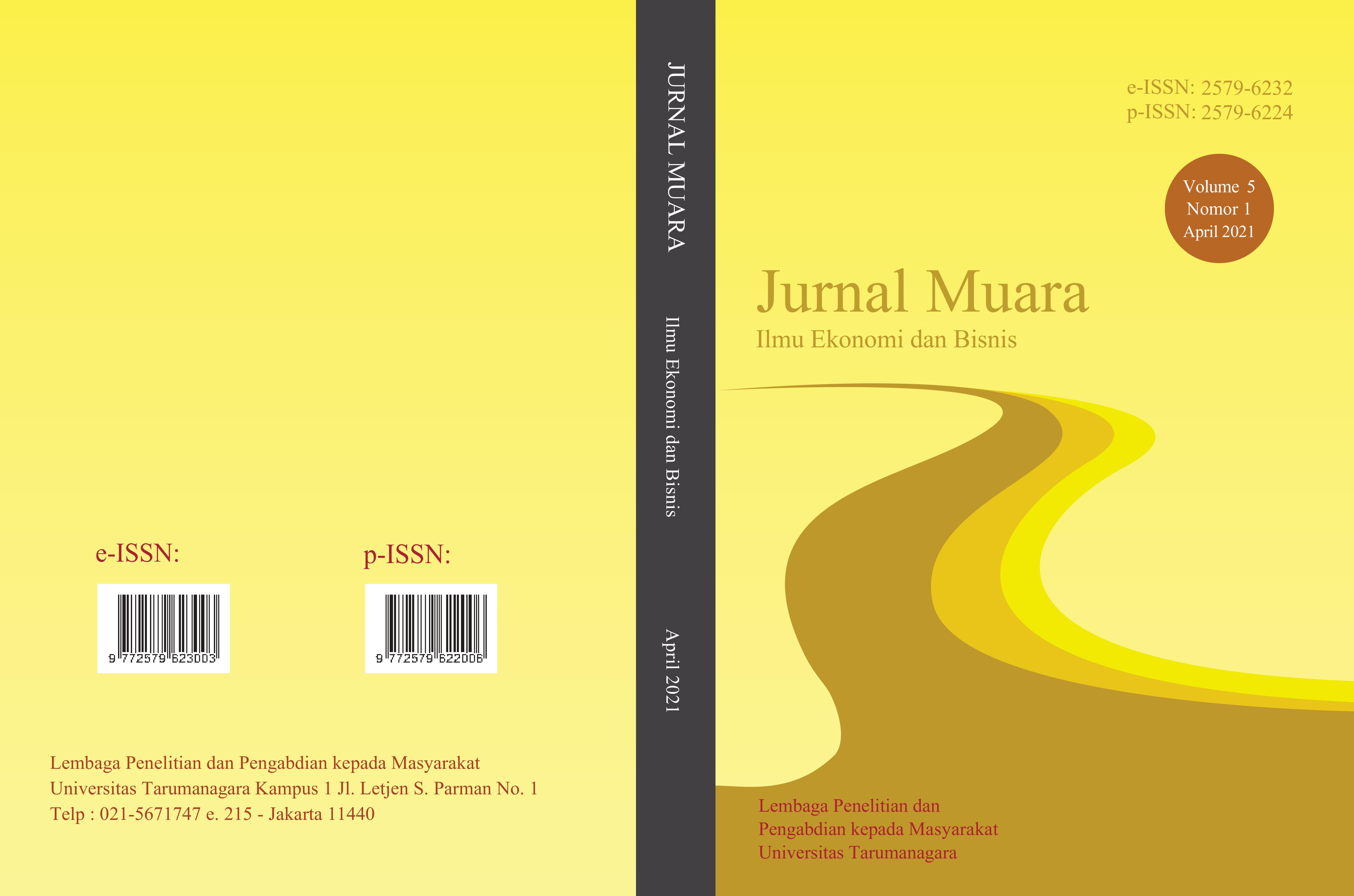THE INFLUENCE OF MEMORABLE SOUVENIRS SHOPPING EXPERIENCE AND PLACE IDENTITY ON REVISIT INTENTION (THE CASE OF YOGYAKARTA)
Main Article Content
Abstract
Yogyakarta adalah penyumbang terbesar kedua bagi Indonesia setelah Bali untuk industri pariwisata dan salah satu dari tiga wilayah emas yang disebut sebagai Joglosemar (Yogyakarta, Solo, dan Semarang). Malioboro salah satu ikon di Yogyakarta, tempat ini menjadi yang paling banyak dikunjungi oleh wisatawan domestik. Penelitian ini berupaya untuk mengetahui pengaruh pengalaman belanja souvenir berkesan pada niat mengunjungi kembali dengan variabel mediasi yaitu identitas tempat dan hubungan masing-masing variabel. Metode penelitian ini adalah kuantitatif, di mana data yang dikumpulkan melalui kuesioner online menggunakan Google Form dan menyebar ke responden target, yaitu orang-orang yang telah mengunjungi Yogyakarta. PLS 3.2.8 digunakan sebagai alat untuk menganalisis data. Hasil penelitian menunjukkan adanya dampak langsung dari pengalaman belanja souvenir berkesan pada niat mengunjungi kembali dan juga identitas tempat pada niat mengunjungi kembali. Penelitian ini juga membuktikan peran mediasi identitas tempat dalam hubungan antara pengalaman belanja souvenir berkesan dan niat mengunjungi kembali. Implikasi penelitian juga dibahas dalam penelitian ini .Penelitian lanjutan dapat menambah variabel lain yang berkaitan dengan pengalaman pariwisata.
Yogyakarta is the second biggest contributor after Bali for Indonesia tourism industry. This area is also known as Joglosemar (Yogyakarta, Solo, and Semarang), a golden triangle for tourism. Malioboro is one of the icons in Yogyakarta, this place become the most visited destination by domestic tourists. This research attempted to find the impact of memorable souvenir shopping experience on revisit intention with place identity as the mediating variable. The methodology of this research was quantitative in nature, where the data collected using google form online questionnaire spreading to the target respondents who are the visitors of Yogyakarta. PLS 3.2.8 was adopted as a tool to analyze the data. The result showed that there is a direct impact of memorable souvenirs shopping experience on revisit intention and also place identity on revisit intention. This research also showed a mediating role of place identity in the relationship between memorable souvenirs shopping experience and revisit intention. The managerial implication was also discussed. The future research may add another variable related to tourist experience.
Article Details
References
Baker, D. A., & Crompton, J. L. (2000). Quality, Satisfaction and Behavioral Intentions. Annals Tourism Research, 27 (3), 785-804. https://doi.org/10.1016/S0160-7383(99)00108-5.
Campos, A. C., Mendes, J., Valle, P. D., & Scott, N. (2016). Co-Creation Experiences: Attention and Memorability. Journal of Travel & Tourism Marketing, 33, 1309-1336.
https://doi.org/10.1080/10548408.2015.1118424
Cary, S. H. (2004). The tourist moment. Annals of Tourism Research, 31 (7), 61-77. https://doi.org/10.1016/j.annals.2003.03.001.
Chairy, & Syahrivar, J. (2019). Bika Ambon of Indonesia: history, culture, and its contribution to tourism sector. J. Ethn. Food 6, 2. https://doi.org/10.1186/s42779-019-0006-6
Cuba, L., & Hummon, D. (1993). A Place to Call Home: Identification with Dwelling, Community, and Region. The Sociological Quarterly, 34(1), 111-131. Retrieved March 29, 2021, from http://www.jstor.org/stable/4121561
Fridgen, J. D. (1984). Environmental psychology and tourism. Annals of Tourism Research, 11(1), 19-39. https://doi.org/10.1016/0160-7383(84)90094-X.
George, B.P. & George, B.P. (2004). Past visits and the intention to revisit a destination: Place attachment as the mediator and novelty seeking as the moderator. Journal of Tourism Studies, 15(2), 37-50. Available at SSRN: https://ssrn.com/abstract=2111025
Ghozali, I. (2011). Structural Equation Modeling Metode Alternatif Dengan Partial Least Square (PLS) Edisi 3. Semarang: Universitas Diponegoro.
Hudson, S., & Ritchie, J. R. B. (2009). Branding a memorable destination experience. The case of ‘Brand Canada’. International Journal of Tourism Research 11, 217–228. DOI: 10.1002/jtr.720.
Hui, T.K., Wan, D., & Ho, A. (2007). Tourist' satisfaction, recommendation, and revisiting Singapore. Tourism Management, 28(4), 965-975. https://doi.org/10.1016/j.tourman.2006.08.008.
Khuong, M. N., & Ha, H. T. (2014). The Influences of Push and Pull Factors on the International Leisure Tourists’ Return Intention to Ho Chi Minh City, Vietnam — A Mediation Analysis of Destination Satisfaction. International Journal of Trade, Economics and Finance, 5(6), 490-494.
Kim, J. H., Ritchie, J. R., & McCormick, B. (2012). Development of a Scale to Measure Memorable Tourism Experiences. Journal of Travel Research, 12-25.
Kyle, G., Bricker, K., Graefe, A., & Wickham, T. (2004). An examination of recreationists’relationships withactivities and settings. Leisure Sciences 26(2), 123–142. https://doi.org/10.1080/01490400490432019
Loureiro, S. M. (2014 ). The role of the rural tourism experience economy in place attachment and behavioral intentions, International Journal of Hospitality Management 40 , 1–9. https://doi.org/10.1016/j.ijhm.2014.02.010.
Prayag, G., & Ryan, C. (2012). Antecedents of Tourists’ Loyalty to Mauritius: The Role and Influence of Destination Image, Place Attachment, Personal Involvement, and Satisfaction. Journal of Travel Research 51(3), 342–356. https://doi.org/10.1177/0047287511410321
Relph, E. (1976). Place and Placelessness. London: Pion.
Sekaran, U., & Bougie, R. J. (2016). Research Method for Business. 7th edition. New York: Wiley.
Selstad. (2007). The social anthropology of the tourist experience. Exploring the "Middle Role". Journal of Hospitality and Tourism, 7(1), 19-33. https://doi.org/10.1080/15022250701256771
Sthapit, E., Coudounaris, D. N., & Bjork, P. (2018). The memorable souvenir-shopping experience: antecedents and outcome. Leisure Studies, 37(5), 628-643. https://doi.org/10.1080/02614367.2018.1519031
Supriwanto & Tunjungsari, H. K. (2020) Mediasi Tourist's Engagement dalam Pengaruh Interactive e-Referral pada Intention to Visit dan e-Referral Sharing Behavior Festival Cap Go Meh Singkawang. Jurnal Muara Ilmu Ekonomi dan Bisnis, Vol. 4 (2), 261-273. DOI: 10.24912/jmieb.v4i2.8031
Timothy, D. J. (2005). Shopping tourism, retailing and leisure. Clevedon: Channel View Publications. DOI: https://doi.org/10.21832/9781873150610
Tunjungsari, H. K., Selamat, F., & Chairy, C. (2019). Pengukuran Destination Awareness Wisatawan Domestik pada Candi Muaro Jambi. Jurnal Komunikasi, 11(2), 233-247. DOI: 10.24912/jk.v11i2.5796
UNWTO. (2018). 2017 International Tourism Results The Highest In Seven Years. Madrid: Sustainable Development Goals.
Wibowo, C. P., & Roostika, R. (2019). Building Positive Word-of-Mouth in the Shopping Tourism. Review of Integrative Business and Economics Research, 8, 372-386.
Wijayanti, A., & Damanik, J. (2019). Analysis of the tourist experience of management of a heritagetourism product: case study of the Sultan Palace of Yogyakarta,Indonesia. Journal of Heritage Tourism, 14(2), 166-177. https://doi.org/10.1080/1743873X.2018.1494182





